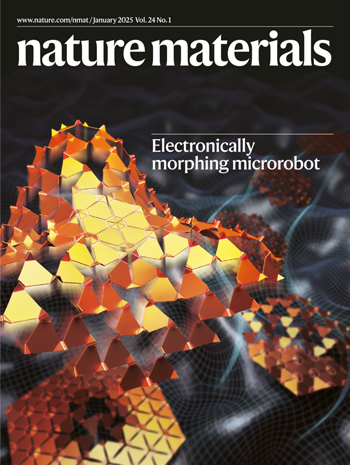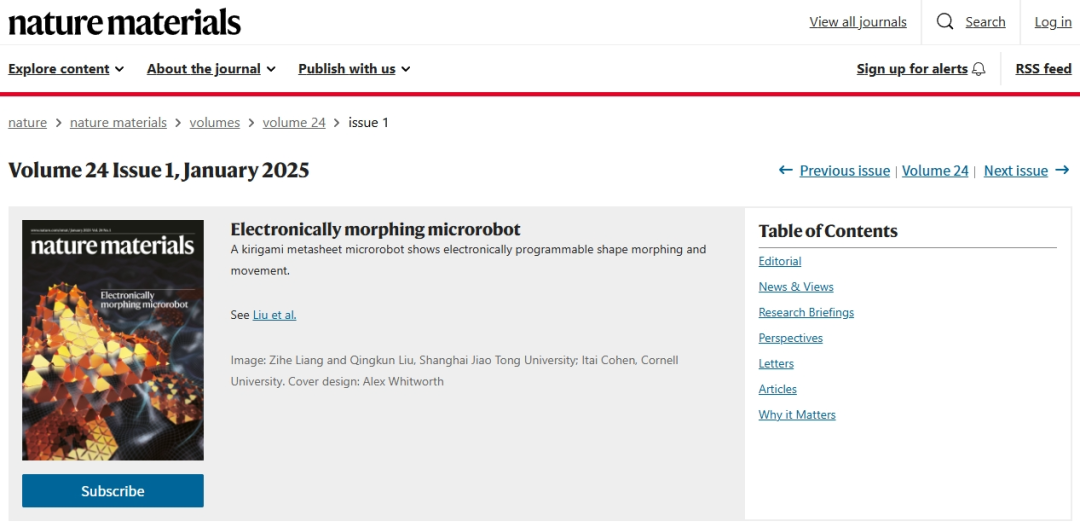
Volume 24 Numéro 1, janvier 2025
Qingkun Liu, Wei Wang, Himani Sinhmar, Itay Griniasty, Jason Z. Kim, Jacob T. Pelster, Paragkumar Chaudhari, Michael F. Reynolds, Michael C. Cao, David A. Muller, Alyssa B. Apsel, Nicholas L. Abbott, Hadas Kress-Gazit, Paul L. McEuen et Itai Cohen
La couverture de ce numéro de Matériaux naturels est "Robots microscopiques à feuilles méta configurables électroniquement" publié par Professeur Itai Cohen de l'Université Cornell et Professeur agrégé Liu Qingkun de l'Université Jiao Tong de Shanghai.

Contexte de la recherche
En microbiologie, la transformation de forme est essentielle au mouvement des microorganismes. Cependant, réaliser ce changement de forme dans des robots submillimétriques a toujours représenté un défi technique. En effet, avec la réduction de la taille, les obstacles liés à la miniaturisation (difficultés de fabrication, conception du mécanisme d'entraînement, etc.) deviennent particulièrement importants. Par conséquent, le développement de robots capables de réaliser des changements de forme à l'échelle microscopique est crucial pour le développement de la technologie microrobotique.
Importance de la recherche
Cette étude a démontré avec succès la capacité de microrobots électroniques programmables et déformables à métasurface en surmontant les défis posés par la miniaturisation. Ces robots utilisent une structure kirigami d'ordre de grandeur cinq, composée de charnières électrochimiques de 10 nanomètres et de panneaux dépliables de 100 micromètres, pour une expansion locale. Ces panneaux sont organisés en cellules unitaires capables de se dilater et de se contracter de 40 %, créant une métasurface avec plus de 200 charnières et des zones indépendantes pilotées électroniquement, dans un format de robot d'environ 1 mm. Cette conception permet au robot de basculer entre différentes géométries cibles avec des distributions de courbure uniques. En pilotant électroniquement des zones indépendantes et en préréglant les retards de phase, cette étude a également permis d'obtenir la démarche du robot.
Ce résultat de recherche démontre non seulement la faisabilité des changements morphologiques à l'échelle microscopique, mais ouvre également une nouvelle voie pour le développement de robots microscopiques, continus, souples et programmables. Il s'agit non seulement d'une avancée majeure dans le domaine de la robotique, mais il fournit également une base théorique et un support technique pour un large éventail d'applications telles que les micromachines reconfigurables, les métasurfaces optiques accordables et les microdispositifs biomédicaux.
Perspectives de recherche
Ce résultat de recherche devrait favoriser le développement d'une série d'applications innovantes. Dans le domaine des micromachines reconfigurables, cette technologie de modification morphologique microscopique peut être utilisée pour fabriquer des micromachines capables d'ajuster automatiquement leur forme en fonction des changements environnementaux ou des exigences des tâches. Dans le domaine des métasurfaces optiques accordables, l'ajustement dynamique de la morphologie de la métasurface permet une manipulation précise de la lumière, révolutionnant ainsi des domaines tels que les communications optiques, l'imagerie et la détection. De plus, en biomédecine, ce microrobot programmable devrait être utilisé dans des domaines de pointe tels que la médecine de précision, l'administration in vivo de médicaments et la microchirurgie, améliorant considérablement l'efficacité et la précision médicales.
Processus de conception de la couverture
Nos horaires
Lundi 21/11 - Mer 23/11 : 9h - 20h
Jeu. 24/11 : fermé - Joyeux Thanksgiving !
Vendredi 25/11 : 8h00 - 22h00
Sam 26/11 - Dim 27/11 : 10h - 21h
(toutes les heures sont l'heure de l'Est)